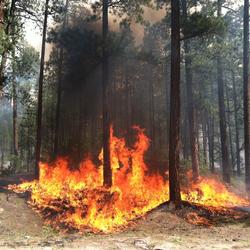The Good, the Bad, the Ugly: How Wildfires Reshape Landscapes
Exploring USGS’s Role in Understanding Postfire Changes
Wildland Fire Science Strategy
New USGS Strategy Harnesses State-of-the-Art Science to Tackle Wildfires Before, During and After the Flames
USGS Wildland Fire Science
Supporting the Nation's Wildland Fire Management Challenges
USGS Emergency Assessment of Post-Fire Debris-Flow Hazards
How Wildfires Threaten U.S. Water Supplies
The USGS is working to measure and predict post-fire water quality and quantity.
Wildland Fire Science
USGS Fire Science is fundamental to understanding the causes, consequences, and benefits of wildfire and helps prevent and manage larger, catastrophic events. USGS scientists possess diverse technical capabilities that are used to address a variety of problems posed by wildland fires. Outcomes of USGS science can be used by fire and land managers to respond to fire-related issues when they arise.







